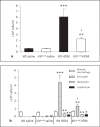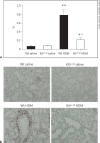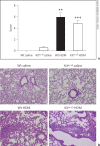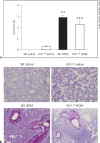Mast cell-deficient kit mice develop house dust mite-induced lung inflammation despite impaired eosinophil recruitment
- PMID: 24157568
- PMCID: PMC6741476
- DOI: 10.1159/000354984
Mast cell-deficient kit mice develop house dust mite-induced lung inflammation despite impaired eosinophil recruitment
Abstract
Background: Mast cells are implicated in allergic and innate immune responses in asthma, although their role in models using an allergen relevant for human disease is incompletely understood. House dust mite (HDM) allergy is common in asthma patients. Our aim was to investigate the role of mast cells in HDM-induced allergic lung inflammation.
Methods: Wild-type (Wt) and mast cell-deficient Kit(w-sh) mice on a C57BL/6 background were repetitively exposed to HDM via the airways.
Results: HDM challenge resulted in a rise in tryptase activity in bronchoalveolar lavage fluid (BALF) of Wt mice, indicative of mast cell activation. Kit(w-sh) mice showed a strongly attenuated HDM- induced recruitment of eosinophils in BALF and lung tissue, accompanied by reduced pulmonary levels of the eosinophil chemoattractant eotaxin. Remarkably, Kit(w-sh) mice demonstrated an unaltered capacity to develop lung pathology and increased mucus production in response to HDM. The increased plasma IgE in response to HDM in Wt mice was absent in Kit(w-sh) mice.
Conclusion: These data contrast with previous reports on the role of mast cells in models using ovalbumin as allergen in that C57BL/6 Kit(w-sh) mice display a selective impairment of eosinophil recruitment without differences in other features of allergic inflammation.
Copyright © 2013 S. Karger AG, Basel
Figures







Similar articles
-
The interleukin-33 receptor ST2 is important for the development of peripheral airway hyperresponsiveness and inflammation in a house dust mite mouse model of asthma.Clin Exp Allergy. 2016 Mar;46(3):479-90. doi: 10.1111/cea.12683. Clin Exp Allergy. 2016. PMID: 26609909
-
Methods for Experimental Allergen Immunotherapy: Subcutaneous and Sublingual Desensitization in Mouse Models of Allergic Asthma.Methods Mol Biol. 2021;2223:295-335. doi: 10.1007/978-1-0716-1001-5_20. Methods Mol Biol. 2021. PMID: 33226602
-
Lipopolysaccharide inhibits Th2 lung inflammation induced by house dust mite allergens in mice.Am J Respir Cell Mol Biol. 2013 Mar;48(3):382-9. doi: 10.1165/rcmb.2012-0331OC. Epub 2012 Dec 13. Am J Respir Cell Mol Biol. 2013. PMID: 23239494
-
Pathobiology and Regulation of Eosinophils, Mast Cells, and Basophils in Allergic Asthma.Immunol Rev. 2025 May;331(1):e70018. doi: 10.1111/imr.70018. Immunol Rev. 2025. PMID: 40235366 Free PMC article. Review.
-
Re-defining the unique roles for eosinophils in allergic respiratory inflammation.Clin Exp Allergy. 2014 Sep;44(9):1119-36. doi: 10.1111/cea.12358. Clin Exp Allergy. 2014. PMID: 24961290 Free PMC article. Review.
Cited by
-
General, but not myeloid or type II lung epithelial cell, myeloid differentiation factor 88 deficiency abrogates house dust mite induced allergic lung inflammation.Clin Exp Immunol. 2017 Feb;187(2):204-212. doi: 10.1111/cei.12867. Epub 2016 Oct 13. Clin Exp Immunol. 2017. PMID: 27625307 Free PMC article.
-
Immunoglobulin E-Dependent Activation of Immune Cells in Rhinovirus-Induced Asthma Exacerbation.Front Allergy. 2022 Feb 22;3:835748. doi: 10.3389/falgy.2022.835748. eCollection 2022. Front Allergy. 2022. PMID: 35386658 Free PMC article.
-
Mast Cells and Their Progenitors in Allergic Asthma.Front Immunol. 2019 May 29;10:821. doi: 10.3389/fimmu.2019.00821. eCollection 2019. Front Immunol. 2019. PMID: 31191511 Free PMC article. Review.
-
Interferon-λ: Inters Ferocity or Inter-Ferocities?J Innate Immun. 2015;7(3):223. doi: 10.1159/000381250. Epub 2015 Mar 24. J Innate Immun. 2015. PMID: 25823916 Free PMC article. No abstract available.
-
LPS aggravates lung inflammation induced by RSV by promoting the ERK-MMP-12 signaling pathway in mice.Respir Res. 2020 Jul 21;21(1):193. doi: 10.1186/s12931-020-01453-6. Respir Res. 2020. PMID: 32693803 Free PMC article.
References
-
- Braman SS. The global burden of asthma. Chest. 2006;130:4S–12S. - PubMed
-
- Murphy DM, O'Byrne PM. Recent advances in the pathophysiology of asthma. Chest. 2010;137:1417–1426. - PubMed
-
- Nelson RP, Jr, DiNicolo R, Fernandez-Caldas E, Seleznick MJ, Lockey RF, Good RA. Allergen-specific IgE levels and mite allergen exposure in children with acute asthma first seen in an emergency department and in nonasthmatic control subjects. J Allergy Clin Immunol. 1996;98:258–263. - PubMed
-
- Lodge CJ, Lowe AJ, Gurrin LC, Hill DJ, Hosking CS, Khalafzai RU, Hopper JL, Matheson MC, Abramson MJ, Allen KJ, Dharmage SC. House dust mite sensitization in toddlers predicts current wheeze at age 12 years. J Allergy Clin Immunol. 2011;128:782–788. e9. - PubMed
Publication types
MeSH terms
Substances
LinkOut - more resources
Full Text Sources
Other Literature Sources
Medical

